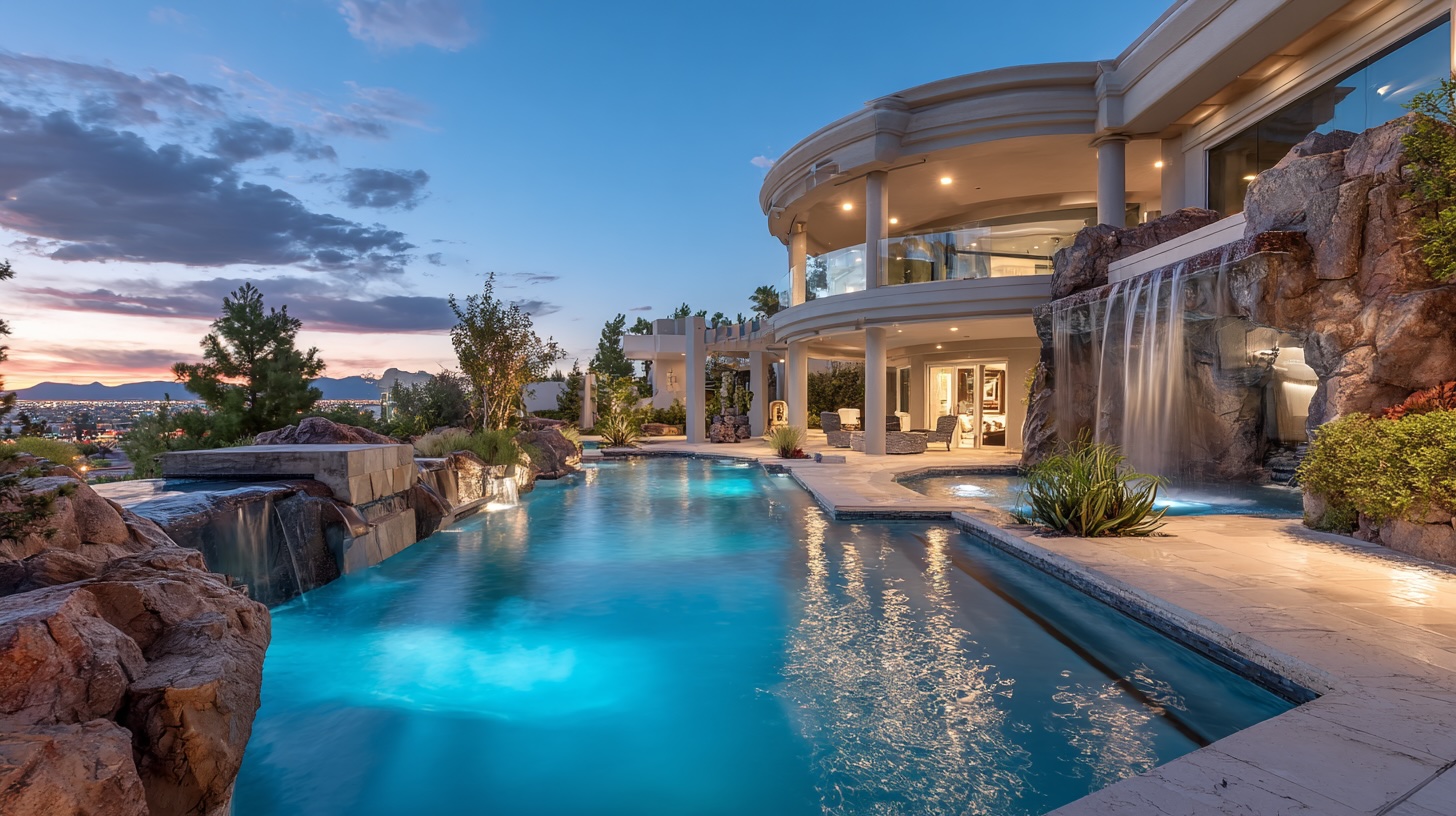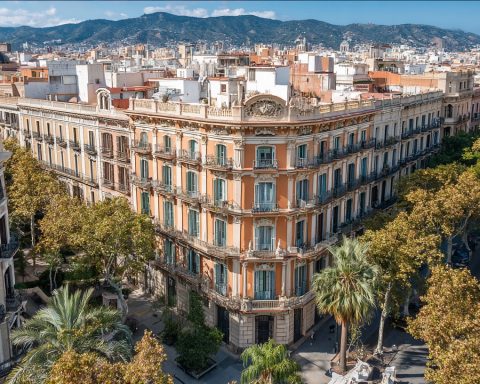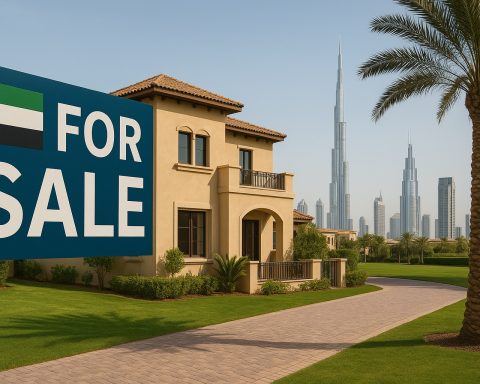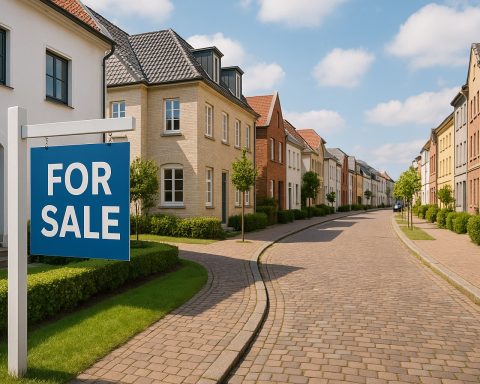Aerial view of new suburban housing developments in Enterprise, NV, reflecting the rapid growth of this southwest Las Vegas Valley community.
Overview – Two Hotspots in the Las Vegas Market
North Las Vegas and Enterprise, Nevada are emerging as dynamic real estate hotspots in 2025, each with distinct characteristics. North Las Vegas (a city in the valley’s north) offers relatively affordable housing and an industrial boom, while Enterprise (an unincorporated town in the southwest valley) is experiencing explosive growth in upscale residential communities and commercial development. Both areas are benefiting from Southern Nevada’s robust economy, population influx, and major infrastructure projects. This report examines residential and commercial trends in each submarket, current market metrics, the investment climate (cap rates, ROI potential, development projects), key demographic/economic drivers, comparisons with broader Las Vegas trends, and expert forecasts through 2029.
Residential Real Estate Trends (2025)
North Las Vegas: The residential market in North Las Vegas remains strong but stabilizing. Home prices have risen modestly – the median sold price in May 2025 was about $416,000, up ~2.8% year-over-year rocket.com. This submarket is still considered a seller’s market, with demand exceeding supply, as it has been since last year rocket.com. Homes here tend to be more affordable than the Las Vegas metro median, attracting first-time buyers and families. Inventory has increased slightly, giving buyers a bit more selection – 1,383 homes were on the market in May 2025, a 6.5% jump from April rocket.com. Despite this, houses continue to sell briskly: ~62% of homes sold within 30 days in May rocket.com. The typical listing goes under contract in just over a month (average 33 days on market, up from 27 days a year ago) rocket.com. Sellers are still closing near asking price, though bidding wars have cooled – about 21% of sales closed over list price in May, while 40% sold under list (often reflecting buyer negotiations on higher-priced listings) rocket.com rocket.com. North Las Vegas’s residential growth is fueled by its relative affordability (median prices ~$70K below the metro median) and new master-planned communities adding housing inventory. Notably, builders like D.R. Horton are delivering projects such as Valley Vista’s Juno Pointe townhomes (priced from ~$309K), bringing modern “affordable luxury” units with community amenities to the area sierralasvegas.com sierralasvegas.com. This aligns with the city’s young demographic (median age 33) and median household income ($76K) that seek value-oriented housing census.gov realestate.usnews.com.
Enterprise (SW Las Vegas): The Enterprise residential market is booming and maturing. This area – encompassing master-planned communities like Mountain’s Edge and Southern Highlands – has seen faster price appreciation. The median home sold price hit $492,871 in May 2025 (up a robust 6.9% year-over-year) rocket.com, and median listing prices are around $550,000 realtor.com, significantly higher than the metro median. After years of frenetic growth, conditions in Enterprise have shifted to a more neutral/balanced market in 2025 rocket.com. Inventory is on the rise – 1,213 homes for sale in May, up 13.6% from the prior month rocket.com – which has eased some upward pressure on prices. Homes still sell relatively quickly (median ~25 days to pending) zillow.com zillow.com, but buyers have a bit more breathing room than last year. In fact, 57% of recent sales in Enterprise closed below asking price (only 15% sold over asking) as sellers adjust expectations in a cooling market rocket.com rocket.com. New construction remains a big factor: the far southwest is filled with ongoing residential projects, from apartment complexes to single-family subdivisions. In the Mountain’s Edge area alone (Enterprise’s southeastern corner), numerous apartment communities and hundreds of single-family homes are under construction or recently completed reviewjournal.com. These new developments are diverse – ranging from entry-level condos to upscale homes – and aim to meet the relentless demand from inbound residents. Enterprise’s desirability is driven by its high quality of life: newer housing stock, abundant parks and amenities, and top-rated schools in some neighborhoods. Its residents are comparatively affluent and educated (median household income ~$88,600, well above the Las Vegas average) reviewjournal.com. This has supported a strong rental market too – many investors target Enterprise for single-family rentals given low vacancy (<4%) and above-average rents, as discussed later sierralasvegas.com.
Las Vegas Metro Context: Broadly, the Las Vegas housing market in 2025 is leveling into stability after the red-hot pandemic-era growth. As of early 2025 the metro-wide median home price is around $475,000, essentially flat compared to a year prior resimpli.com. Available inventory has been rising – by May, over 7,100 single-family homes were on the market valley-wide, roughly a 3.4-month supply (up from ~3 months in April) ricelasvegas.com ricelasvegas.com. This ~10% monthly jump in supply gave buyers more options and slightly cooled sales pace ricelasvegas.com ricelasvegas.com. Even so, demand remains healthy, buoyed by population growth and relatively affordable prices versus coastal markets. North Las Vegas and Enterprise epitomize this balance: NLV provides affordability and is still a seller’s market due to entry-level demand, while Enterprise’s higher price point and construction boom have ushered in a neutral market. Both submarkets, however, are aligned with the metro’s overall trend of slower price gains and increased equilibrium between buyers and sellers in 2025.
Key 2025 Housing Metrics: North Las Vegas vs. Enterprise vs. Metro
To summarize the residential market stats, the table below compares key metrics for North Las Vegas and Enterprise, alongside the Las Vegas metro averages:
Table: Selected Housing Market Metrics (2025)
| Metric (2025) | North Las Vegas | Enterprise (SW Las Vegas) | Las Vegas Metro Overall |
|---|---|---|---|
| Median Sold Price (May 2025) | ~$416,000 (+2.8% YoY) rocket.com | ~$493,000 (+6.9% YoY) rocket.com | ~$480,000 (≈0% YoY) resimpli.com |
| For-Sale Inventory (May 2025) | 1,383 homes (+6.5% MoM) rocket.com | 1,213 homes (+13.6% MoM) rocket.com | ~7,100 homes (+10% MoM) ricelasvegas.com |
| Avg Days on Market (May 2025) | 33 days (up from 27 YoY) rocket.com | 40 days (up from 30 YoY) rocket.com | ~35 days (metro avg, up YoY) rocket.com rocket.com |
| % of Sales Under List Price | ~40% rocket.com | ~57% rocket.com | ~45% (est. for valley, 2025) |
| Median Rent (Dec 2024) | ~$1,700 (3-bed home) | ~$2,050 (3-bed home) sierralasvegas.com | $1,794 (all units avg, +2.6% YoY) resimpli.com |
Sources: Zillow, Rocket Homes, Review-Journal, Resimpli, SierraLV – see citations.
As shown above, Enterprise commands higher home prices than North Las Vegas (and the metro overall), reflecting its newer housing and desirability. North Las Vegas, with a median sale price in the low $400Ks, remains one of the more affordable submarkets in Clark County resimpli.com. Both areas saw inventory growth in 2025, part of a metro-wide trend as listings increase and sales volume cools ricelasvegas.com ricelasvegas.com. Homes in North Las Vegas tend to sell a bit faster than in Enterprise, on average, but selling times have risen slightly across the board as the market normalizes. Rents are strong in both: a typical three-bedroom single-family rental in Enterprise fetches over $2,000/month, higher than the metro average (~$1,800) sierralasvegas.com resimpli.com. North Las Vegas rents are slightly lower but still elevated after pandemic-era rent surges (Las Vegas rents jumped ~40–50% from 2020 to 2024) resimpli.com. Notably, Enterprise, Summerlin, and Henderson are seeing the most dramatic rent increases in 2024–25, as their rental vacancy rates stay under 4% – a landlord’s dream scenario of tight supply and rising yields sierralasvegas.com.
Commercial Real Estate Trends (Office, Retail, Industrial)
While residential markets are crucial, North Las Vegas and Enterprise are also experiencing significant action in commercial real estate – particularly in industrial and retail development, with some emerging office growth.
Industrial Real Estate: North Las Vegas has cemented itself as Southern Nevada’s industrial powerhouse, thanks largely to the massive Apex Industrial Park and other warehouse/distribution hubs in the city. Industrial demand in Las Vegas remains high, but after years of breakneck expansion the market is showing signs of balancing. As of late 2024, the valley’s industrial vacancy rate had edged into double digits (~10.6%) for the first time in over a decade resimpli.com, as a wave of new warehouse supply outpaced absorption. By Q1 2025, Las Vegas’s industrial inventory reached ~194 million sq. ft., with a staggering 14.6 million sq. ft. still under construction to be delivered in coming years mdlgroup.com mdlgroup.com. Cap rates for industrial properties have averaged about 5.3% in early 2025 sales mdlgroup.com – slightly higher than the ultra-low rates seen in 2021–22, reflecting a normalization of prices and higher interest rates. In North Las Vegas, new big-box facilities continue to come online, but there’s a notable shift: developers are cautiously moderating new projects amid rising vacancy and construction costs nevadabusiness.com nevadabusiness.com. Land and infrastructure constraints are a key challenge – Apex, a ~18,000-acre industrial area 26 miles northeast of downtown, had long been slowed by the need to build out water and utilities nevadabusiness.com. That’s now improving; a public-private push including a $250+ million water line and wastewater system expansion (in partnership with the Southern Nevada Water Authority) is bringing vital infrastructure to Apex nevadabusiness.com. As a result, Apex’s future looks much brighter. The park currently has nearly 15 million sq. ft. of projects planned or underway nevadabusiness.com, on top of 5.5 million sq. ft. already completed cityofnorthlasvegas.com cityofnorthlasvegas.com. Major companies have recently opened large facilities there – for example, Kroger’s 988,000 sq. ft. distribution center and a 1 million sq. ft. Crocs/Hey Dude footwear warehouse are now operational in Apex cityofnorthlasvegas.com. Developers are land-banking for the next phase of growth: Prologis (a global logistics REIT) purchased 879 acres at Apex for a multi-building project (its second-largest land acquisition nationally) and CapRock Partners acquired 85 acres to build a 1.48 million sq. ft. industrial park due in 2025 cityofnorthlasvegas.com cityofnorthlasvegas.com. VanTrust Real Estate’s Vantage North project is another major undertaking – a 350-acre logistics park in southern Apex that will offer up to 4.6 million sq. ft. of space (its first tenant, Saddle Creek Logistics, already occupies 580K sq. ft.) cityofnorthlasvegas.com. All of this underscores North Las Vegas’s industrial momentum: the city is capitalizing on Nevada’s geographical advantage for distribution (reaching ~24% of the U.S. population within a 2-day truck haul) nevadabusiness.com nevadabusiness.com and its pro-growth approach. However, the industrial sector is also entering a more tenant-favored phase – higher vacancy and more options mean some occupiers are pausing expansions or negotiating harder on rents resimpli.com resimpli.com. We anticipate industrial rent growth to temper and vacancy to rise further in the short term resimpli.com, but long-run prospects for North Las Vegas remain strong given continued e-commerce and logistics demand. Enterprise also plays a role in industrial real estate, albeit smaller: parts of Enterprise along I-15 and Blue Diamond Road host warehousing and flex spaces, but this submarket is more constrained and focused on other uses (retail, office, residential). Enterprise’s industrial vacancy aligns with the overall Southwest valley rate, which is still relatively low; many new warehouses are concentrated in North Las Vegas or Henderson due to land availability.
Office Real Estate: The Las Vegas office market in 2025 is stable but bifurcated. Metro-wide office vacancy is around 12.2%, roughly the same as a year ago, indicating stabilization post-pandemic cbre.com. Enterprise (Southwest Las Vegas) is actually a standout performer in the office sector – the Southwest submarket boasts the lowest vacancy in the region at only 6.7% cbre.com. This reflects a trend: the southwest valley (Enterprise area) has quickly become Las Vegas’s “fourth office node,” joining the traditional office hubs of downtown, Summerlin (west), and Green Valley/Henderson (southeast) reviewjournal.com reviewjournal.com. Proximity to the Strip and master-planned communities, along with abundant developable land, has spurred a cluster of new medical offices, corporate campuses, and flex office spaces around the I-215/Durango corridor. For instance, the UnCommons development in Enterprise delivered modern office space (alongside retail and apartments) and attracted major tenants like DraftKings. Big firms are expanding in this area – Deloitte recently took additional space in the Southwest submarket cbre.com – drawn by newer buildings and freeway access. In contrast, some older submarkets (e.g. the Central East) struggle with high vacancy (~27%) as tenants favor suburban locations or remote work arrangements cbre.com. One concern is the lack of new office construction: virtually no new office buildings broke ground in Las Vegas in late 2024 or Q1 2025 resimpli.com cbre.com. While this has helped prevent oversupply, there’s apprehension about meeting future demand for Class A space in high-growth areas like Enterprise. Office rents are rising fastest in the most desirable submarkets – e.g. the western suburbs command asking rents around $3.10/sqft per month (full service) cbre.com, whereas older central areas see ~$2.40/sqft cbre.com. In Enterprise, expect continued office development in coming years: with the Brightline high-speed rail station and a new sports arena planned at the south Strip (more on these below), the area is poised for more corporate real estate projects. However, the nature of office use is evolving; many projects are low-rise, mixed-use centers (like medical office plazas or flex office/warehouse combos) rather than traditional high-rises.
Retail Real Estate: Retail is resurgent in both North Las Vegas and Enterprise, driven by population growth and new master-planned communities. In fact, Enterprise and the southwest valley are leading the region in retail development – a striking 58% of all new retail space delivered in the Las Vegas metro since 2023 has been in the Southwest submarket (Enterprise) reviewjournal.com. Since January 2023, about 128,000 sq. ft. of retail was added in Enterprise, with another ~6,000 sq. ft. under construction as of mid-2024 reviewjournal.com reviewjournal.com. New retail centers often follow rooftops: as thousands of homes were built in Mountain’s Edge and surrounding areas, retail developers responded with shopping plazas, grocery-anchored centers, and entertainment hubs. Recent high-profile completions include UnCommons (which features not only offices and apartments but also trendy restaurants and shops) and the Durango Station Casino resort, which opened in late 2023 with a slate of dining and retail options reviewjournal.com. Under construction now are projects like a Costco Wholesale store on a 22-acre site at Buffalo Dr & 215 Beltway (south Enterprise) and an Ashley Furniture HomeStore west of the IKEA in Enterprise reviewjournal.com. These will further solidify the area’s retail offerings. Meanwhile, North Las Vegas is seeing its own retail renaissance, particularly with ambitious mixed-use projects. The biggest buzz is around the former Texas Station & Fiesta casino sites, where a massive new development called Hylo Park is planned.
Rendering of the planned Hylo Park mixed-use development on the 73-acre former Texas Station & Fiesta Rancho site in North Las Vegas. The $380 million project will bring shops, restaurants, sports facilities, a hotel, and ~700 homes, transforming the area into a vibrant live-work-play “village.”
Hylo Park – North Las Vegas: Slated to break ground in 2025, Hylo Park exemplifies the next generation of retail and commercial development in North Las Vegas. This $380 million project will turn a 73-acre empty lot (where two casinos were razed during the pandemic) into a walkable urban village reviewjournal.com reviewjournal.com. Plans include nearly 700 residential units, a 175-room hotel, a multitude of fast-casual and sit-down restaurants (an In-N-Out Burger is already approved as an anchor pad) reviewjournal.com reviewjournal.com, big-box retail (one building will host a 40,000 sq. ft. retailer) reviewjournal.com, plus office space, a daycare, and even a car wash reviewjournal.com. The hallmark, however, is a sprawling youth sports and entertainment complex – described as an “Olympic village” for community sports. Hylo Park will feature a 158,000 sq. ft. indoor multisport facility, an outdoor sports field/stadium for soccer games and events, and a 30,000 sq. ft. educational sports academy for kids reviewjournal.com. Additionally, the Vegas Golden Knights NHL franchise is partnering with the city on a two-sheet ice hockey arena to be incorporated on site (plans for this 100,000 sq. ft. ice rink facility were initiated in 2023) reviewjournal.com. In short, Hylo Park will blend retail, entertainment, and residential uses to create a new community hub in North Las Vegas. For local real estate, it means hundreds of new homes and a major value-add to surrounding property values once amenities are in place. It also signifies North Las Vegas’s commitment to redevelopment and quality-of-life projects for its residents.
Beyond Hylo Park, North Las Vegas is seeing other retail and mixed-use investments. Agora Realty is spearheading downtown revitalization – a “Gateway” project of $200 million is in works to redevelop blocks in the historic downtown, in partnership with the city connectcre.com. And in neighborhood retail, older shopping centers are getting makeovers (e.g., a renovation on an established retail plaza noted to start in 2025 projects.constructconnect.com). Overall, the retail sector in both Enterprise and North Las Vegas is benefiting from pent-up demand (many suburban areas were under-served for shopping/dining) and Nevada’s resurgent consumer spending post-Covid. We’re seeing strong leasing for well-located retail (national chains are expanding here) and relatively low retail vacancy in new projects. Importantly, new developments are heavily focused on experiential and convenience retail – e.g. food courts, entertainment, grocery, and services – that align with the preferences of the growing local population.
Current Market Metrics & Investment Climate
From an investment standpoint, North Las Vegas and Enterprise offer distinct opportunities. Key market health indicators as of 2025 include median prices, inventory levels, days on market, rent rates, and cap rates, which we’ve covered in sections above. Now we interpret what they mean for investors and the general climate:
- Housing Inventory & Absorption: Inventory has been on the rise in 2025, moving Las Vegas from an extreme seller’s market toward a more balanced market. Months of supply in the valley is hovering around 3 to 4 months – still slightly favoring sellers (a true buyer’s market is >6 months supply) ricelasvegas.com, but much less frenzied than 2021-2022. In North Las Vegas and Enterprise, this means investors have more selection and can negotiate a bit more on purchase price than in recent years. Notably, in Enterprise, the shift to a neutral market (from a strong seller’s market last year) rocket.com suggests that large price run-ups are leveling off, reducing risk of overpaying for assets in 2025.
- Price Appreciation & Equity: Both submarkets are still seeing year-over-year home price growth (Enterprise ~6–7%, NLV 3%), albeit modest. This steady appreciation contributes to solid equity gains for homeowners. For investors, it indicates continued upside but at a sustainable pace. Gone are the double-digit annual jumps; instead, forecast models predict 3–5% annual home price growth in Las Vegas through 2026 sierralasvegas.com. The median sale price valley-wide ($420–480K) is expected to rise to roughly $440K by early 2026 sierralasvegas.com sierralasvegas.com. For context, the National Association of Realtors projects only about ~2% home price growth nationally in 2025 realwealth.com, so Las Vegas may outperform slightly due to its strong in-migration and limited housing supply. This moderate appreciation outlook makes the market attractive for long-term investors seeking both cash flow and gradual appreciation, rather than speculators chasing rapid spikes.
- Rental Market & Yields: The rental environment is robust, particularly in Enterprise. Average rents have increased ~4% year-over-year metro-wide sierralasvegas.com. As of early 2025, typical rents are about $1,320 for a 1-bedroom, $1,660 for a 2-bedroom, and $2,050 for a 3-bedroom single-family home in the Las Vegas area sierralasvegas.com sierralasvegas.com. Enterprise and other high-demand neighborhoods are seeing the fastest rent hikes, and rental vacancy rates under 4% mean units rent quickly sierralasvegas.com. For investors, this translates to a favorable ROI potential: strong tenant demand and rising rents support healthy cap rates on rental properties. Many single-family rentals in North Las Vegas can still be acquired in the $300Ks and rented for ~$1,800-$2,200/month, which often pencils out to cap rates in the 6-7% range (higher than many markets). Enterprise rentals, while pricier to buy, command premium rents – a new 4-bedroom home might rent for $2,500+, offering competitive returns and high appreciation potential. On the commercial side, cap rates have adjusted upward across asset classes in Vegas, improving cash-on-cash yields for new investors (though also reflecting higher financing costs). Industrial assets at ~5.3% cap mdlgroup.com and retail centers in the 6-7% range are attainable. Office cap rates have widened to 7%+ on average blog.thebrokerlist.com given work-from-home headwinds, meaning savvy investors can acquire office buildings at lower prices per income stream – albeit with more risk. Overall, Nevada’s tax-friendly status (no state income tax) sierralasvegas.com and the relatively low cost of properties (Las Vegas prices are much lower than California’s) make both North Las Vegas and Enterprise appealing for out-of-state investors seeking better yields.
- Development & ROI: One trend is the opportunity to invest in or near new developments. Buying land or properties in the path of growth – for example, around the planned Brightline station in Enterprise or near the Apex industrial park – could yield significant ROI as those projects mature. Major developments often raise surrounding property values and spur additional commerce. We’ve already detailed Hylo Park (which itself is a potential mixed-use investment opportunity, with planned retail condos, etc.), and in Enterprise the Brightline corridor is expected to become a new commercial spine. Investors looking for value-add opportunities might target older housing in North Las Vegas for renovation (as newer retail and industry comes in, there’s demand for quality rentals), or consider small retail strip centers to serve the booming Enterprise population.
- Risk Factors: It’s important to note potential challenges. Rising interest rates have made financing more expensive, which could pressure cap rates upward further and temper price growth. Also, Las Vegas is not immune to economic swings – it historically faces volatility due to its tourism-based economy. However, recent economic diversification (more on this next) is mitigating that risk. From a construction standpoint, high construction costs and land prices have slowed some new projects nevadabusiness.com, but this also keeps supply in check, which can protect values of existing properties. Institutional investors have also been active in Las Vegas real estate (about 23% of home sales are to investors) resimpli.com, which has pros and cons: it adds competition for buyers, but also indicates confidence in the market’s long-term fundamentals.
In summary, the investment climate in North Las Vegas and Enterprise is optimistic. With solid population growth fueling demand, ROI prospects are strong, especially for rentals and value-add residential flips or infill developments. Cap rates in Southern Nevada are generally higher than the national average, giving investors better cash flow potential. As one local expert quipped, “In Vegas, the house always wins — especially when you own the house.” sierralasvegas.com The key is to pick the right submarket and asset type aligned with the growth trends outlined here.
Key Demographic & Economic Drivers
Both North Las Vegas and Enterprise benefit from the same overarching forces driving the Las Vegas metro’s growth: a steady influx of new residents, job creation, and pro-business economic policies. Here are some of the most important demographic and economic drivers:
- Explosive Population Growth: Southern Nevada’s population continues to surge, and Enterprise is leading the pack. From 2010 to 2023, Enterprise’s population grew by nearly 60%, reaching about 245,243 residents at end of 2023 reviewjournal.com. It is projected to add ~13,700 more residents by 2028 reviewjournal.com, which would bring it close to 260,000 people – rivaling Henderson and North Las Vegas in size. This nearly 4% annual growth rate in Enterprise is over twice the growth rate of the Las Vegas Valley overall reviewjournal.com. North Las Vegas is also among the fastest-growing cities in Nevada (and the U.S.); it currently has about 279,000 residents and is growing ~2.7% per year worldpopulationreview.com. A younger demographic profile (NLV’s median age ~33; Enterprise ~36) and larger household sizes mean continued household formation and housing demand. Crucially, a significant portion of new residents are coming from higher-cost states (California, Pacific Northwest) seeking affordable homes and jobs – 72% of people moving to Vegas cite lifestyle and cost-of-living improvements as motivation resimpli.com.
- Increasing Incomes & Education: Along with more people, Enterprise in particular is attracting a more affluent and educated base. The median household income in Enterprise (as noted) is $88K reviewjournal.com, far above the metro median ($65K). A full 25% of Enterprise adults have a bachelor’s degree (versus ~19% valley-wide) reviewjournal.com, and many others have associate or graduate degrees. These higher-income, professional residents drive demand for larger homes, quality retail, and services – hence the proliferation of upscale developments in the southwest. North Las Vegas’s median income, around $75K census.gov, has also been climbing as the city sheds its past image and brings in new employers. Both submarkets benefit from Nevada’s low-tax environment, which draws retirees and remote workers as well. Additionally, the area’s population is diverse and relatively young, which supports a vibrant housing market across the spectrum (from starter homes to luxury estates).
- Job Growth & Diversification: The Las Vegas economy has rebounded strongly from the pandemic, and it’s evolving beyond just hospitality. Major investments in tech, manufacturing, logistics, and healthcare are taking place, many of them in North Las Vegas and Enterprise. For example, North Las Vegas’s Apex Park has lured high-tech manufacturing (like the Air Liquide hydrogen plant) cityofnorthlasvegas.com, and other industrial employers that provide blue-collar and skilled trade jobs. Meanwhile, the medical sector is expanding in the southwest valley (new hospitals, clinics, and research facilities), and companies like Amazon, Google, and Switch have large data centers and fulfillment centers around the valley. The result is a more resilient job market sierralasvegas.com. Southern Nevada’s unemployment in 2025 is relatively low, and wage growth is evident in sectors outside of gaming. Tourism is still a backbone – and Las Vegas visitation in 2024-2025 is setting records again – but the growth of industries like logistics (supported by the new industrial capacity) and film/media (with big studios planned) is reducing reliance on the Strip. Notably, Warner Bros. and Sony announced huge investments in film production facilities in Las Vegas (a planned $8.5B studio expansion over 17 years by Warner, and a $1.8B Sony studio in Summerlin) resimpli.com resimpli.com, which could create thousands of jobs and stimulate the real estate market for production offices, housing for crew, etc. Such diversification means more stable long-term housing demand – as one industry slows, another can pick up slack.
- Infrastructure & Connectivity: Key infrastructure projects are set to boost the local economy and real estate values. Foremost among them is Brightline West, the high-speed rail line that will connect Las Vegas to Southern California. Construction began in April 2024 with $12 billion in funding reviewjournal.com. The Las Vegas Brightline station will be in Enterprise, on a 33-acre site along Las Vegas Blvd just south of the Strip en.wikipedia.org. When it opens in 2028, it’s expected to whisk passengers to the Los Angeles area in about 2 hours reviewjournal.com. This rail project is not only a transportation game-changer but also a job creator (construction and operations) and a catalyst for transit-oriented development. Surrounding the station, developers are envisioning a new 66-acre sports and entertainment district, including a potential 20,000-seat arena by Oak View Group on adjacent land en.wikipedia.org. The station and arena will likely spur hotels, apartments, and office spaces in Enterprise, further driving real estate activity. Likewise, the region continues to invest in freeways (the I-15/I-215 interchange upgrades, new Beltway exits) and community infrastructure (schools, parks) to support growth. North Las Vegas recently partnered on a major water pipeline project for Apex (discussed prior) – infrastructure that unlocks thousands of acres for development nevadabusiness.com. Such projects ensure that growth in housing and industry can continue sustainably, which is a positive sign for long-term investors.
- Government and Business Climate: Both local governments – City of North Las Vegas and Clark County (which governs Enterprise) – are known for being pro-development and business-friendly. North Las Vegas in particular has streamlined permitting to attract companies (it touts itself as one of the fastest-growing cities and actively recruits new employers) cityofnorthlasvegas.com. Tax incentives and zoning flexibility have drawn in manufacturing plants and distribution centers that might otherwise have gone to neighboring states. At the state level, Nevada’s lack of personal and corporate income tax, relatively low property taxes, and favorable regulatory environment continue to attract businesses and new residents. This “tax haven” status sierralasvegas.com is a significant driver; for example, many Californians relocate to Las Vegas to escape high taxes, fueling demand for homes in areas like Enterprise. Additionally, the rise of remote work has allowed people to move to Las Vegas for its lower cost of living while keeping their higher-paying jobs elsewhere, injecting more disposable income into the local economy. Southern Nevada’s leadership is also heavily investing in quality-of-life improvements (witness the sports teams – the NFL’s Raiders stadium opened in 2020, an MLB stadium coming by 2028, new parks, etc.), which in turn attract more residents and tourists. All these factors – people, jobs, connectivity, and a friendly business climate – create a virtuous cycle sustaining the real estate market’s growth.
Notable Developments & Infrastructure Projects
Several major developments and infrastructure projects in and around North Las Vegas and Enterprise are shaping the real estate outlook. We’ve touched on some (Brightline, Apex, Hylo Park), but here’s a roundup of the most impactful projects to watch:
- Brightline West High-Speed Rail: Location: South Strip in Enterprise. Timeline: Under construction (broke ground 2024), aiming for completion by 2027–2028. Impact: This project will connect Las Vegas to Victor Valley, CA and onwards to Los Angeles via high-speed trains reaching 200 mph reviewjournal.com. The Las Vegas terminus station in Enterprise (on Las Vegas Blvd near Blue Diamond Rd) will be a large complex with retail, restaurants, a 2,400-space parking garage, and connections to local transit like the Vegas Loop en.wikipedia.org en.wikipedia.org. Adjacent, a 20,000-seat arena and entertainment district is planned, indicating a sports-centric development boom in the area en.wikipedia.org. Real estate around the station is expected to surge in value; new hotels, multifamily, and offices are anticipated to cluster nearby to serve the influx of travelers and businesses leveraging the rail link. It effectively extends Los Angeles’ commuter shed to Las Vegas, which could introduce bi-state commuters and further housing demand in Enterprise (imagine living in affordable Vegas and day-tripping to California for work or vice versa).
- Oakland A’s Las Vegas Ballpark: Location: Not in NLV/Enterprise (it’s on the Strip corridor), but regionally significant. Timeline: Planned MLB stadium, targeted opening for the 2028 season reviewjournal.com. Impact: A brand-new 33,000-seat baseball stadium on the Tropicana hotel site (south Strip) will solidify Las Vegas as a major league city. While the stadium is in Paradise (just east of Enterprise), the economic ripple effects will be felt valley-wide – construction jobs now, permanent jobs later, and an expected boost in tourism. For real estate, it could increase short-term rental demand and spur more residential interest in areas like Enterprise that are a quick drive from the stadium. It’s part of a broader ~$7 billion in new Strip developments from 2023–2028 (including new casinos like Fontainebleau, the Sphere venue, etc.), which collectively raise Las Vegas’s profile and economy resimpli.com resimpli.com. A stronger overall economy lifts housing markets in North Las Vegas and Enterprise alike.
- Apex Industrial Park Expansion (North Las Vegas): Location: Far Northeast Las Vegas (north of NLV city proper). Timeline: Ongoing – infrastructure phase 2023-2025, private development 2024 onward. Impact: As detailed earlier, Apex is undergoing a transformation from a long-dormant industrial expanse to a bustling logistics and manufacturing hub. The $250+ million infrastructure investment (new water and wastewater systems connecting Apex to metropolitan utilities) is a game changer nevadabusiness.com. With Prologis, CapRock, and others planning millions of square feet of warehouses, thousands of new jobs will be created in the next few years. This drives housing demand in North Las Vegas – many Apex workers may seek homes in NLV for proximity. We expect to see ancillary development too: truck stops, housing, and services along the I-15 corridor by Apex. Additionally, the City of North Las Vegas has proposed an UNLV North Campus on 2,000 acres near Apex reviewjournal.com, which could eventually bring educational facilities and research parks to the area (this is a long-term vision, but the land is earmarked). Such a campus would further diversify the economy and spur residential projects for student/faculty housing in North Las Vegas.
- Hylo Park & NLV Downtown Revitalization: Location: Central North Las Vegas (Rancho Dr & Lake Mead Blvd). Timeline: Phase 1 approved Dec 2024, groundbreak expected 2025; multi-phase development likely through 2026–2027. Impact: Hylo Park’s mixed-use “urban village” will be one of the largest development investments in NLV’s history reviewjournal.com. It not only replaces blighted empty land with productive use, but also includes unique amenities (sports facilities, hotel, etc.) that will draw visitors from across the metro. Property values in the immediate vicinity (e.g. North Las Vegas’s mature neighborhoods like Rancho, Northstar Estates) should see a bump in values as the project progresses. The city’s broader downtown revitalization plan (including a new North Las Vegas Justice Center, upgraded streetscapes, and public-private partnerships for retail) will complement Hylo Park, aiming to create a vibrant city center. As these materialize, North Las Vegas could shed lingering stigmas and become a trendy place to live and work, boosting demand for its real estate. It’s worth noting that North Las Vegas officials tout the city as “the 5th fastest-growing in the U.S.”, and projects like these are both a result of and catalyst for that growth cityofnorthlasvegas.com.
- Retail & Entertainment in Enterprise: Location: Southwest Las Vegas Valley (Enterprise). Timeline: 2023–2025 deliveries and beyond. Impact: We mentioned UnCommons (a major mixed-use campus with office, 500 apartments, food hall, etc., completed 2022-2023) and the Durango Casino & Resort (opened late 2023) reviewjournal.com. Building on those, additional retail projects (Costco, Ashley Furniture, local shopping centers) are under construction in Enterprise reviewjournal.com. These developments greatly enhance the amenity base for residents – no longer do they have to drive to Summerlin or Henderson for major shopping, as more options are opening nearby. Real estate in Enterprise has become more valuable as infrastructure catches up (widened roads like Blue Diamond, new schools, and now major retail). Also, hospitality projects like the M Resort’s new 384-room hotel tower in nearby Henderson’s west side (opening summer 2025) reviewjournal.com and expansions of local casinos (e.g. Red Rock’s Durango expansion reviewjournal.com) create jobs and draw more people to the area. All indicate confidence in the southwest valley’s growth trajectory. For homebuyers and investors, the influx of retail and entertainment means Enterprise is transitioning from a suburban bedroom community to a more self-contained urban center, often raising home values and rent prices as convenience improves.
In essence, infrastructure and development projects are both supporting and responding to the population and real estate boom. North Las Vegas’s industrial and downtown projects will supply jobs and modern amenities, making the city more attractive to residents (and encouraging further residential construction). Enterprise’s transit and entertainment projects will knit it closer to the Strip and create an urban vibe, driving demand for housing and commercial space. These projects collectively ensure that 2025–2029 will be a transformative period for both areas, setting the foundation for sustained real estate growth.
Comparisons with Broader Las Vegas Trends
It’s helpful to place North Las Vegas and Enterprise in the context of the broader Las Vegas metro real estate trends:
- Home Prices: Las Vegas as a whole has seen flattening prices around record highs (~$480K median in 2025) resimpli.com after a huge run-up in 2020–2022. North Las Vegas remains more affordable than the metro average, with median prices roughly 15–20% lower than the overall median (and even ~25% lower than affluent parts like Summerlin). This parallels other outer-ring areas of Vegas; for example, downtown Las Vegas median is $400K resimpli.com, and North Las Vegas’s $416K is in that range – in contrast to Summerlin ($600K) or Henderson ($520K) resimpli.com resimpli.com. Enterprise, on the other hand, skews above the metro median, similar to other popular suburbs. Its ~$550K median listing price realtor.com is on par with many Green Valley and Spring Valley neighborhoods. In terms of price growth, Enterprise’s ~5–7% annual appreciation recently outpaced the Las Vegas average (which was roughly flat to +3% depending on segment), indicating it’s a particularly hot submarket. North Las Vegas’s ~3% growth rocket.com is closer to the Clark County average. Both areas thus reflect an ongoing metro trend: higher-end suburbs are appreciating faster (due to scarce new supply and amenity desirability), while entry-level markets see slower gains but remain in demand due to affordability.
- Market Conditions: The entire metro is shifting from a seller’s market toward balance. However, North Las Vegas is one of the few areas still categorized as a Seller’s Market in 2025 (with demand notably strong) rocket.com, whereas Enterprise has cooled to a Neutral Market rocket.com. This dichotomy highlights that price point matters – the buyer pool for mid-priced homes (like those in North Las Vegas) is bolstered by local workforce and investors, keeping competition high. In pricier Enterprise, buyers have become more discerning as higher interest rates bite into affordability at the $500K+ level, aligning with trends seen in upscale parts of Summerlin or Henderson. Metro-wide, sales volumes have dipped (Las Vegas home sales in early 2025 are down year-over-year), and we see that in both areas: Rocket Homes data showed North Las Vegas sales (closed+pending) in May 2025 were down ~9.7% from April rocket.com rocket.com, and Enterprise saw a MoM sales drop as well rocket.com. This is in line with the Las Vegas Realtors’ reports of overall slower sales and slightly rising inventory in 2025 ricelasvegas.com. Days on market creeping up in NLV (33 days from 27) rocket.com and Enterprise (40 from 30) rocket.com mirror the metro’s trend (overall DOM around 30+ days, up from sub-2 weeks at peak frenzy).
- Construction & Inventory: New construction has been a metro theme – Las Vegas had a homebuilding boom in recent years (albeit tempered by land constraints). Enterprise saw a large share of that, given its open land, which is why inventory there expanded more and the market balanced out faster. North Las Vegas also has new construction (NLV’s master plans like Tule Springs, Valley Vista add homes each year), but it’s relatively less in percentage terms. The entire metro’s housing inventory is up ~30% year-over-year as of 2025 redfin.com (Redfin noted 17,489 homes for sale in Nevada in April 2025, up 32% YoY redfin.com). Both Enterprise and NLV contributed to that rise. Compared to the broader trends: Summerlin and Henderson also have new developments but those are more constrained by land and high prices, so their inventories remain tight. Outer areas like North Las Vegas and parts of Southwest (Enterprise) have been the “relief valve” adding supply to the metro. As a result, homebuyers have more choices in NLV and Enterprise now than, say, in 2021, making these markets healthier and less bubble-prone.
- Rental & Investment Trends: Regionally, Las Vegas saw a huge spike in institutional investor activity in 2021-2022 (investors bought up ~18%+ of homes at peak) resimpli.com. That has cooled somewhat, but investors (including iBuyers and build-to-rent developers) remain active, especially in entry-level segments. North Las Vegas, with many single-story homes and comparatively low prices, is a prime target for rental investors – paralleling nationwide trends where suburbs with good yields attract institutional landlords. Enterprise sees more owner-occupant demand due to higher prices and larger homes, though its strong rents have also drawn interest in the luxury rental market. In multifamily, Las Vegas metro occupancy and rent growth have been solid; Enterprise leads on rent growth, as noted, similar to Henderson and Summerlin – all areas where new luxury apartments lease up quickly due to affluent tenants. North Las Vegas historically had fewer large apartment complexes, but that’s changing as developers recognize the growing workforce there (expect more multifamily in NLV city in coming years). In the metro context, cap rates in Las Vegas are higher than in coastal cities, which is why money continues to flow here – this applies equally to commercial assets (industrial, office, retail) and residential rentals.
- Economic & Infrastructure Alignment: Broad Las Vegas trends like diversification, infrastructure expansion, and the arrival of pro sports benefit the entire valley. We can compare that North Las Vegas is capturing the industrial diversification piece (aligning with the metro push to be a logistics hub, akin to how Reno/Tahoe did), while Enterprise is capturing the entertainment and knowledge economy growth (tech offices, sports facilities, etc.). Both submarkets together illustrate the multi-polar growth of Las Vegas – no longer is everything centered on the Strip. Instead, we have strong nodes in the northwest (NLV), southwest (Enterprise), southeast (Henderson/Green Valley), and of course the traditional Strip/Resort Corridor. This decentralization is a metro trend that really took hold in the 2010s and is in full swing mid-2020s. The result is that housing and commercial demand is spread across the valley, rather than only radiating out from one core, giving areas like NLV and Enterprise a chance to flourish equally.
In summary, North Las Vegas and Enterprise reflect and reinforce Las Vegas’s overall trajectory: rapid growth transitioning into a more sustainable phase, with local variations in price level and pace. Both areas are integral to the metro’s future—North Las Vegas fueling the region’s industrial and affordable housing needs, and Enterprise driving retail, office, and high-end suburban living. Compared to the broader metro, NLV remains a value play with high growth potential, and Enterprise stands out as a booming suburb with upscale momentum.
Forecast & Outlook (2026–2029)
Looking ahead, the real estate outlook for North Las Vegas and Enterprise over the next 3–5 years (2026 through 2029) is generally optimistic, with continued growth expected, though at a moderated pace. Here are expert insights and forecasts to consider:
- Home Price Forecasts: Most analysts project that Las Vegas home values will continue to appreciate modestly in the coming years. The consensus forecast for the metro is on the order of 3%–5% annual price growth sierralasvegas.com, assuming no major recession. The SierraLV investment outlook anticipates Las Vegas median home prices reaching roughly $440K+ by early 2026 (from ~$420K in early 2025) sierralasvegas.com sierralasvegas.com, and then continuing an upward climb through 2029. This implies that by 2029, median prices could be in the mid-$500Ks if compounded. North Las Vegas is expected to appreciate slightly faster than the metro average in percentage terms (because it’s starting from a lower base and catching up), perhaps 4% annually, given the strong population growth and new infrastructure (e.g., as Apex development ramps up, more workers will seek housing there). Enterprise might see growth closer to the higher end of forecasts (4-5% yearly) in the next couple years, fueled by its desirability and the completion of amenities like the Brightline station and arena by 2027-2028, which could spur a mini-boom in property values in the immediate vicinity. However, as Enterprise is more built-out, its growth could temper later in the decade if land supply tightens. It’s also worth noting these projections presume interest rates stabilize; if rates significantly drop in late 2020s, Las Vegas could see an extra jump in prices due to renewed affordability, whereas if rates rise further, price growth might undershoot forecasts.
- Rental Market Outlook: Expect rent prices to keep trending upward in both submarkets, albeit at a moderate 3-4% annual rate (in line with income growth). Enterprise should maintain low vacancies, especially as more businesses open in the area, drawing renters who want to live near new jobs. We anticipate built-to-rent communities (entire subdivisions of single-family homes for rent) to appear on the fringes of North Las Vegas and Enterprise, given national trends – this could slightly increase rental supply, but likely not enough to outpace demand. By 2028, the average Las Vegas rent could be roughly 15% higher than today; metro rents are projected to rise ~3% yearly through 2025 resimpli.com, and that trend may hold barring oversupply. So a $1,800 average could become ~$2,100 by 2029. High-growth zones like Enterprise might see even higher rent inflation if population influx continues strongly.
- Commercial Real Estate: Industrial sector outlook remains positive long-term: Las Vegas is establishing itself as a key Western distribution hub. There may be a near-term soft patch (2025-2026) with higher vacancy as the current construction pipeline delivers resimpli.com, but by 2027-2028 that space is expected to be absorbed as the economy grows. North Las Vegas’s Apex park will likely be hitting stride by 2026+ with multiple facilities operational – that will bolster city tax revenues and employment. Office sector is forecast to slowly recover; Las Vegas office using employment is growing, and by 2026-2027 more new office projects may resume as current vacancies fill. Enterprise should continue to outperform in office (with perhaps some new mid-rise offices around the Brightline station by 2028-29). Retail in these submarkets should flourish alongside population – experiential and neighborhood retail will be in demand. One caveat: like the rest of the U.S., higher interest rates and construction costs have put some commercial projects on hold. But as stability returns, expect a construction resurgence around 2026 to meet the needs of the thousands of new residents moving in each year.
- Major Developments Timeline: By 2026, many of the projects described will be either completed or well underway. Hylo Park’s first phases (retail and some residential) are likely to open by 2026, enhancing North Las Vegas’s image. Brightline West is scheduled to start service in 2028 en.wikipedia.org, which could cause a spike in nearby property demand just beforehand (savvy investors may start positioning in 2026-27). The Oak View arena in Enterprise might also be under construction around that time for a late-decade debut. And of course, the A’s ballpark in 2028 will be a headline event reviewjournal.com. All these will contribute to a bullish sentiment in Southern Nevada real estate through the latter half of the decade. Analysts often note that Las Vegas is entering a “mega-project era” where large-scale projects (rail, stadiums, resorts) will keep the economy humming reviewjournal.com reviewjournal.com. North Las Vegas and Enterprise, while not hosting all these projects, benefit as integral pieces of the metro.
- Risks & Unknowns: No forecast is without uncertainty. If the U.S. economy hits a recession in 2026 or 2027, Las Vegas could see a temporary dip in housing demand (perhaps flat or slightly down prices for a year). But given the housing undersupply and demographic momentum, any such dip is expected to be short-lived. The consensus from local brokers is cautiously optimistic – for instance, a Re/Max brokerage owner in Las Vegas predicts 2025 and beyond should be “good years” for the valley’s real estate, as the market has already gone through its correction and is on solid footing reviewjournal.com reviewjournal.com. By 2029, Southern Nevada may also face land scarcity in certain areas – which could drive up prices further or shift development to outlying areas (for example, beyond Enterprise further south towards Sloan, or farther north beyond NLV). If California’s housing remains expensive and remote/hybrid work remains common, Las Vegas will continue to attract new residents at high rates, potentially pushing our forecasts on the higher side.
Bottom Line: North Las Vegas and Enterprise are poised for a prosperous next 5 years. Expect a landscape of new homes, new businesses, and new infrastructure. Homeowners in these areas are likely to see steady equity gains, and investors can expect solid returns as rent growth and property appreciation continue. By 2029, North Las Vegas may shed its “secondary city” status and emerge as a major economic center of its own (with a vibrant downtown and industrial base), and Enterprise will likely be fully transformed from open desert to a thriving suburban metropolis with its own identity, possibly even incorporating as a city. The real estate markets in both will mature, characterized by sustainable growth rather than speculative spikes, making them two of the most exciting areas to watch in the Las Vegas metro.
Conclusion
In summary, North Las Vegas and Enterprise, NV represent the twin frontiers of Las Vegas’s 2025 real estate landscape – one in the north cultivating affordability and industrial might, the other in the south cultivating upscale living and commercial innovation. The current market shows balanced growth: home prices are at record levels but rising moderately, inventory is improving, and new developments are enriching each community. Investors and homebuyers are drawn by strong fundamentals: rapid population growth, expanding job opportunities, and transformational projects (from rail lines to sports arenas) that promise long-term prosperity. Over the next 3 to 5 years, these areas are expected to lead Southern Nevada in growth, while largely mirroring the metro’s overall trend of steady, sustainable real estate expansion. For anyone looking to strike real estate gold in “The Silver State,” North Las Vegas and Enterprise are proving that the Las Vegas boom is no longer confined to the Strip – it’s reaching every corner of the valley, turning past dust into tomorrow’s opportunity.
Sources: North Las Vegas & Enterprise housing data from Zillow and Rocket Homes zillow.com rocket.com; market trends and forecasts from local real estate reports ricelasvegas.com sierralasvegas.com; commercial stats from CBRE, MDL Group cbre.com mdlgroup.com; development news from Las Vegas Review-Journal reviewjournal.com reviewjournal.com and City of North Las Vegas cityofnorthlasvegas.com cityofnorthlasvegas.com. These provide a fact-based foundation for the analysis and projections in this report.












